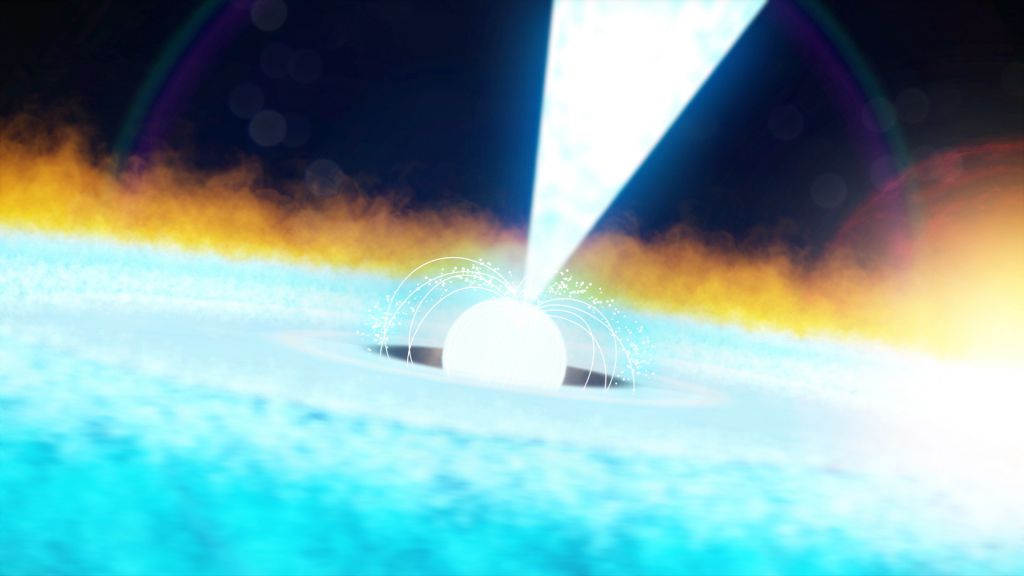NASA space telescope uses 'nuisance light' to peer at neutron star

After 10 years fighting back photons in its peripheral vision, a NASA space telescope now has a way to use "nuisance light" to potentially increase its science productivity.
NASA's NuSTAR (Nuclear Spectroscopic Telescope Array) X-ray space observatory successfully gathered information about a super-dense star, known as a neutron star, that was in its peripheral vision.
Engineers say the design quirk of NuSTAR ended up being a boon in looking at the object (SMC X-1) in X-rays. Neutron stars, which typically occur after supernova explosions, trap gas particles with their magnetic fields. The X-rays are generated as the particles are accelerated and energized during a journey to the star's surface.
Related: NASA's NuStar spots most powerful light ever seen on Jupiter
"This paper shows that this stray light approach is reliable, because we observed brightness fluctuations in the neutron star in SMC X-1 that we have already confirmed through direct observations," lead author McKinley Brumback, an astrophysicist at the California Institute of Technology in Pasadena, California, said in a statement from NASA's Jet Propulsion Laboratory (JPL).
"Going forward, it would be great if we could use the stray light data to look at objects when we don't already know if they're regularly changing in brightness, and potentially use this approach to detect changes," Brumback continued.
NuSTAR launched to space in 2012 to study the cosmos in high-energy X-rays, providing a valuable addition to the study of SMC X-1. Its X-ray output pattern was finally established in recent years, following decades of work by NuSTAR and other telescopes to determine how often it changes brightness and why.
Breaking space news, the latest updates on rocket launches, skywatching events and more!
"Scientists have pinpointed several reasons why SMC X-1 changes in brightness when studied by X-ray telescopes," JPL stated. "For example, the X-rays' brightness dims as the neutron star dips behind the living star with each orbit … the stray light data was sensitive enough to pick up on some of those well-documented changes."
NuSTAR's stray light situation comes from a design quirk. The dumbbell-shaped observatory includes a 33-foot-long (10-meter-long) boom and two bulky areas on either end. The observatory typically observes by pointing one bulky end (with the optics). As the light is gathered, it travels and becomes precisely focused through the boom before arriving at the detectors, situated in the opposite bulky zone.

Unfortunately, nuisance light constantly enters the detectors through the sides of the boom as well, creating a faint circle of light on the sides of images. In recent years, NuSTAR team members began using computer models to predict the amount of stray light from various known X-ray sources. The result was an 80-object catalog with stray light observations, nicknamed "StrayCats."
While the stray light does not replace direct observations through the boom, several Caltech students did examine the StrayCats catalog and found examples of potential science, such as rapid brightening that might be attributable to neutron star surface explosions or other events. Tracking this behavior will add more information as to how neutron stars behave, the team said.
A paper based on the research was published Feb. 24 in The Astrophysical Journal.
Follow Elizabeth Howell on Twitter @howellspace. Follow us on Twitter @Spacedotcom and on Facebook.

Elizabeth Howell (she/her), Ph.D., was a staff writer in the spaceflight channel between 2022 and 2024 specializing in Canadian space news. She was contributing writer for Space.com for 10 years from 2012 to 2024. Elizabeth's reporting includes multiple exclusives with the White House, leading world coverage about a lost-and-found space tomato on the International Space Station, witnessing five human spaceflight launches on two continents, flying parabolic, working inside a spacesuit, and participating in a simulated Mars mission. Her latest book, "Why Am I Taller?" (ECW Press, 2022) is co-written with astronaut Dave Williams.
